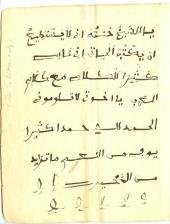Africa and the African Diaspora
The Autobiography in Arabic of a Senegalese Enslaved in North Carolina

Like another 92,000 Senegambian victims of the transatlantic slave trade, Omar ibn Said—born in 1770 in a wealthy and erudite family—was transported to the United States. He landed in Charleston in the last months of 1807, just before the official (if not effective) end of the trade. He ran away and was captured in North Carolina where he spent the rest of his life.
Omar produced several documents in Arabic, and some have been preserved. His earliest and latest known manuscripts are dated 1819 and 1857. Omar was photographed and articles were written about him. Still, he died enslaved in 1863.
 I feel a special connection to Omar. I have an essay in Alryyes’ book, “'God Does not Allow Kings to Enslave Their People': Islamic Reformists and the Transatlantic Slave Trade.” But there is something else, more personal.
I feel a special connection to Omar. I have an essay in Alryyes’ book, “'God Does not Allow Kings to Enslave Their People': Islamic Reformists and the Transatlantic Slave Trade.” But there is something else, more personal.
Omar was made a prisoner during a war to depose Abdul Kader Kane, the Almamy (Muslim leader) of the northern region of Futa Toro. Like other rulers, scholars—a number of whom were later enslaved in the Americas—and 19th century combatants against French colonization, Kane had studied at Pir.
The first and most reputed school of Islamic higher learning in Senegambia, Pir was founded by Khaly Amar Fall (1555-1638), a prince and scholar who had studied in Futa Toro—Omar's birthplace and the cradle of Islam in Senegambia—and in Mauritania. The school Fall (pronounced Faal) established in 1611 played a major role in the religious, cultural, and political life of the region; so much so that the French burnt it down in 1869.
I am a descendant of Khaly Amar Fall, and I am thus particularly delighted that this year marks not only the publication of A Muslim American Slave, but also the 180th anniversary of Omar’s autobiography, and the fourth centennial of Pir, which was widely commemorated in Senegal where the rebuilt school is still thriving and Fall’s 1611 mosque and simple grave are National Historic Landmarks.
For more on African Muslims in the Americas:
- Austin, Allan D. African Muslims in Antebellum America (New York: Routledge 1997)
- Diouf, Sylviane A. Servants of Allah: African Muslims Enslaved in the Americas (New York: New York University Press, 1998)
- Reis, Joao Jose. Slave Rebellion in Brazil: The Muslim Uprising of 1835 in Bahia (Baltimore: Johns Hopkins University Press, 1993)
To see portraits of African Muslims enslaved in the United States, visit In Motion: The African-American Migration Experience.
To read biographies of African Muslims, visit The Abolition of the Transatlantic Slave Trade: The Forgotten Story.
Read E-Books with SimplyE
 With your library card, it's easier than ever to choose from more than 300,000 e-books on SimplyE, The New York Public Library's free e-reader app. Gain access to digital resources for all ages, including e-books, audiobooks, databases, and more.
With your library card, it's easier than ever to choose from more than 300,000 e-books on SimplyE, The New York Public Library's free e-reader app. Gain access to digital resources for all ages, including e-books, audiobooks, databases, and more.
If you don’t have an NYPL library card, New York State residents can apply for a digital card online or through SimplyE (available on the App Store or Google Play).
Need more help? Read our guide to using SimplyE.
Comments
book.
Submitted by Elliott F. Monds (not verified) on November 28, 2013 - 1:35pm